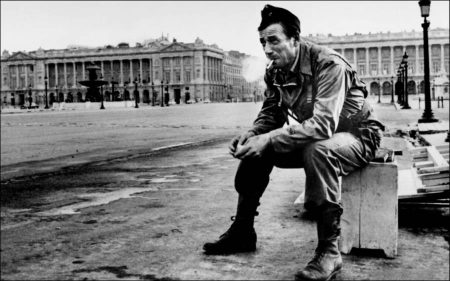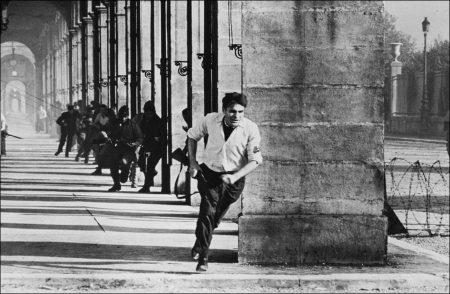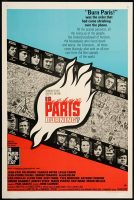Is Paris Burning? movie storyline. Shortly after the failed 20 July plot to assassinate him in 1944, Adolf Hitler appoints General der Infanterie Dietrich von Choltitz as military governor of occupied Paris. Hitler believes Choltitz will obey his order that the Allies should not be allowed to capture Paris without the Germans destroying it completely, similar to the planned destruction of Warsaw.
The French Resistance learn that the Allies are not planning to take Paris, but are heading straight to Germany instead. The two factions within the Resistance react to this news differently. The Gaullists under Jacques Chaban-Delmas want to wait and see, while the Communists under Colonel Rol-Tanguy want to take action. The Communists force the issue by calling for a general uprising by the citizens of Paris and by occupying important government buildings. The Gaullists go along with this plan of action once it is set in motion.
Initially, Choltitz is intent on following Hitler’s order to level the city. After his troops fail to dislodge the Resistance from the Prefecture of Police, he orders the Luftwaffe to bomb the building but withdraws the order at the urging of the Swedish Consul, Raoul Nordling, who points out that bombs that miss the Prefecture risk destroying nearby culturally invaluable buildings such as the Notre Dame Cathedral. Choltitz accepts a truce offer from the Resistance (conceived by the Gaullist faction), but the Communists want to keep on fighting, in spite of a lack of ammunition. The truce is, therefore, shortened to one day and the fighting resumes.
After learning that the Germans plan to destroy Paris (the Eiffel Tower and other landmarks are rigged with explosives), a messenger from the Resistance is sent across enemy lines to contact the Americans. He informs the Allies that the Resistance has already taken control of parts of the city and implores them to provide support to prevent the uprising being crushed as was then happening in Warsaw. He adds that France would never forgive the destruction of Paris. Afterwards General Omar Bradley gives the 2nd Armored Division under General Philippe Leclerc the go-ahead to rush on Paris.
Is Paris Burning? is a 1966 epic war film about the liberation of Paris in August 1944 by the French Resistance and the Free French Forces during World War II. A French-American co-production, it is directed by French filmmaker René Clément, with a screenplay by Gore Vidal, Francis Ford Coppola, Jean Aurenche, Pierre Bost, and Claude Brulé; adapted from the book of the same title by Larry Collins and Dominique Lapierre.
The film stars an international ensemble cast that includes French (Jean-Paul Belmondo, Alain Delon, Bruno Cremer, Pierre Vaneck, Jean-Pierre Cassel, Leslie Caron, Charles Boyer, Yves Montand), American (Orson Welles, Kirk Douglas, Glenn Ford, Robert Stack, Anthony Perkins, George Chakiris), and German (Gert Fröbe, Hannes Messemer, Ernst Fritz Fürbringer, Harry Meyen) stars.
The film was released in France on October 26, 1966 and in the United States on November 10, 1966. It received general positive reviews, and was the fourth most popular movie of the year in France in 1966. It was nominated for Best Cinematography (Black and White) and Academy Award for Best Art Direction at the 40th Academy Awards, and a Golden Globe Award for Best Original Score.
About the Production
The film is based on the best-selling book by Larry Collins and Dominique Lapierre and was directed by René Clément, from a screenplay by Gore Vidal and Francis Ford Coppola. The film was shot in black and white mainly because, although the French authorities would allow Nazi swastika flags to be displayed on public buildings for key shots, they would not permit those flags to be in their original red color; as a result, green swastika flags were used, which photographed adequately in black and white but would have been entirely the wrong color.[citation needed] However, the closing credits feature aerial shots of Paris in color.
The production was filmed in 180 sites throughout Paris; including Rue de la Huchette, Place des Vosges, Les Invalides, Place de la Concorde, Notre-Dame, the Latin Quarter, and Musée Carnavalet. According to screenwriter Francis Ford Coppola, the film’s production was strictly controlled by Charles de Gaulle. The latter would only permit location filming in Paris (which was, of course, crucial) if his rules were obeyed to the letter. In particular, he was anxious to minimize the part played in the Liberation by the French Communist Party; it was, said Coppola, blatant political censorship.
Claude Rich plays two parts: General Leclerc, with a moustache, and Lt. Pierre de la Fouchardière, without a moustache.[citation needed] He is credited at the end only with the part of Leclerc. His role as the young lieutenant is not by chance: Claude Rich, as a teenager, was watching soldiers in the street when the real-life Pierre de la Fouchardière called him into a building to protect him.[citation needed] Actor Orson Welles repeatedly clashed with director René Clément, refusing to speak directly to whom despite being fluent in French. Reportedly, Welles was upset that Clement had been given such a large budget for a project, while he had been struggling to find financing for his projects.
As the film had a predominately French cast, all sequences featuring French and German actors were filmed in their native French and German languages respectively, which was then dubbed into English, while all the sequences with the American actors (including Orson Welles) were filmed in English.[citation needed] Separate French and English-language dubs were produced for their respective territories.
The score was composed by Maurice Jarre. Jarre’s music for “The Paris Waltz” had words added later by Maurice Vidalin and became a patriotic anthem sung by Mireille Mathieu under the title Paris en colère.
Is Paris Burning? (1966)
Directed by: René Clément
Starring: Orson Welles, Jean-Paul Belmondo, Alain Delon, Gert Fröbe, Kirk Douglas, Bruno Cremer, Pierre Vaneck, Leslie Caron, Glenn Ford, Anthony Perkins, Jean-Pierre Cassel
Screenplay by: Gore Vidal, Francis Ford Coppola, Jean Aurenche, Pierre Bost, Claude Brulé
Production Design by: Willy Holt
Cinematography by: Marcel Grignon
Film Editing by: Robert Lawrence
Costume Design by: Pierre Nourry, Jean Zay
Art Direction by: Marc Frédérix, Pierre Guffroy
Makeup Department: Aïda Carange, Michel Deruelle
Music by: Maurice Jarre
MPAA Rating: None.
Distributed by: Paramount Pictures
Release Date: October 20, 1966 (France), November 10, 1966 (United States)
Visits: 216


